
- •Contents
- •Preface to second edition
- •1 Introduction
- •1.2 Applying technology in an environment
- •1.3 The human role in systems
- •1.4 Ethical issues
- •1.7 Common practice and good practice
- •1.8 Bugs and emergent phenomena
- •1.10 Knowledge is a jigsaw puzzle
- •1.11 To the student
- •1.12 Some road-maps
- •2 System components
- •2.2 Handling hardware
- •2.3 Operating systems
- •2.4 Filesystems
- •2.5 Processes and job control
- •2.6 Networks
- •2.7 IPv4 networks
- •2.8 Address space in IPv4
- •2.9 IPv6 networks
- •3 Networked communities
- •3.1 Communities and enterprises
- •3.2 Policy blueprints
- •3.4 User behavior: socio-anthropology
- •3.5 Clients, servers and delegation
- •3.6 Host identities and name services
- •3.8 Local network orientation and analysis
- •4 Host management
- •4.1 Global view, local action
- •4.2 Physical considerations of server room
- •4.3 Computer startup and shutdown
- •4.5 Installing a Unix disk
- •4.6 Installation of the operating system
- •4.7 Software installation
- •4.8 Kernel customization
- •5 User management
- •5.1 Issues
- •5.2 User registration
- •5.3 Account policy
- •5.4 Login environment
- •5.5 User support services
- •5.6 Controlling user resources
- •5.7 Online user services
- •5.9 Ethical conduct of administrators and users
- •5.10 Computer usage policy
- •6 Models of network and system administration
- •6.5 Creating infrastructure
- •6.7 Competition, immunity and convergence
- •6.8 Policy and configuration automation
- •7.2 Methods: controlling causes and symptoms
- •7.4 Declarative languages
- •7.6 Common assumptions: clock synchronization
- •7.7 Human–computer job scheduling
- •7.9 Preventative host maintenance
- •7.10 SNMP tools
- •7.11 Cfengine
- •8 Diagnostics, fault and change management
- •8.1 Fault tolerance and propagation
- •8.2 Networks and small worlds
- •8.3 Causality and dependency
- •8.4 Defining the system
- •8.5 Faults
- •8.6 Cause trees
- •8.7 Probabilistic fault trees
- •8.9 Game-theoretical strategy selection
- •8.10 Monitoring
- •8.12 Principles of quality assurance
- •9 Application-level services
- •9.1 Application-level services
- •9.2 Proxies and agents
- •9.3 Installing a new service
- •9.4 Summoning daemons
- •9.5 Setting up the DNS nameservice
- •9.7 E-mail configuration
- •9.8 OpenLDAP directory service
- •9.10 Samba
- •9.11 The printer service
- •9.12 Java web and enterprise services
- •10 Network-level services
- •10.1 The Internet
- •10.2 A recap of networking concepts
- •10.3 Getting traffic to its destination
- •10.4 Alternative network transport technologies
- •10.5 Alternative network connection technologies
- •10.6 IP routing and forwarding
- •10.7 Multi-Protocol Label Switching (MPLS)
- •10.8 Quality of Service
- •10.9 Competition or cooperation for service?
- •10.10 Service Level Agreements
- •11 Principles of security
- •11.1 Four independent issues
- •11.2 Physical security
- •11.3 Trust relationships
- •11.7 Preventing and minimizing failure modes
- •12 Security implementation
- •12.2 The recovery plan
- •12.3 Data integrity and protection
- •12.5 Analyzing network security
- •12.6 VPNs: secure shell and FreeS/WAN
- •12.7 Role-based security and capabilities
- •12.8 WWW security
- •12.9 IPSec – secure IP
- •12.10 Ordered access control and policy conflicts
- •12.11 IP filtering for firewalls
- •12.12 Firewalls
- •12.13 Intrusion detection and forensics
- •13 Analytical system administration
- •13.1 Science vs technology
- •13.2 Studying complex systems
- •13.3 The purpose of observation
- •13.5 Evaluating a hierarchical system
- •13.6 Deterministic and stochastic behavior
- •13.7 Observational errors
- •13.8 Strategic analyses
- •13.9 Summary
- •14 Summary and outlook
- •14.3 Pervasive computing
- •B.1 Make
- •B.2 Perl
- •Bibliography
- •Index

Chapter 6
Models of network and system administration
Understanding human–computer systems requires an ability to see relationships between seemingly distinct parts of a system. Many failures and security violations result from the neglect of interrelationships within such systems. To model the management of a complete system, we need to understand the complete causal web.
Principle 27 (System interaction). Systems involve layers of interacting (cooperating and competing) components that interdepend on one another. Just as communities are intertwined with their environments, so systems are complex ecological webs of cause and effect. Ignoring the dependencies within a system will lead to false assumptions and systemic errors of management.
Individual parts underpin a system by fulfilling their niche in the whole, but the function carried out by the total system does not necessarily depend on a unique arrangement of components working together – it is often possible to find another solution with the resources available at any given moment. The flexibility to solve a problem in different ways gives one a kind of guarantee as to the likelihood of a system working, even with random failures.
Principle 28 (Adaptability). An adaptable system is desirable since it can cope with the unexpected. When one’s original assumptions about a system fail, they can be changed. Adaptable systems thus contribute to predictability in change or recovery from failure.
In a human–computer system, we must think of both the human and the computer aspects of organization. Until recently, computer systems were organized either by inspired local ingenuity or through an inflexible prescription, dictated by a vendor. Standardizing bodies like the Internet Engineering Task Force (IETF) and International Standards Organization (ISO) have attempted to design models for the management of systems [59, 205]; unfortunately, these models have often proved to be rather short-sighted in anticipating the magnitude

196 CHAPTER 6. MODELS OF NETWORK AND SYSTEM ADMINISTRATION
and complexity of the tasks facing system administrators and are largely oriented on device monitoring. Typically, they have followed the singular paradigm of placing humans in the driving seat over the increasingly vast arrays of computing machinery. This kind of micro-management is not a scalable or flexible strategy however. Management needs to step back from involving itself in too much detail.
Principle 29 (System management’s role). The role of management is to secure conditions necessary for a system’s components to be able to carry out their function. It is not to direct and monitor (control) every detail of a system.
This principle applies both to the machines in a network, and to the organization of people using them and maintaining them. If a system is fundamentally flawed, no amount of management will make it work. First we design a system that functions, then we discuss the management of its attributes. This has several themes:
•Resource management: consumables and reusables.
•Scheduling (time management, queues).
•Strategy.
More recently, the emphasis has moved away from management (especially of devices) as a paradigm for running computer systems, more towards regulation. This is clearly consistent with the principle above: the parts within a system require a certain freedom to fulfill their role, without the constant interference of a manager; management’s role, instead, moves up a level – to secure the conditions under which the parts can be autonomous and yet still work together.
In this chapter we consider the issues surrounding functioning systems and their management. These include:
•The structuring of organizational information in directories.
•The deployment of services for managing structural information.
•The construction of basic computing and management infrastructure.
•The scalability of management models.
•Handling inter-operability between the parts of a system.
•The division of resources between the parts of the system.
6.1 Information models and directory services
One way of binding together an organization is through a structured information model – a database of its personnel, assets and services [181]. The X.500 standard [167] defines:

6.1. INFORMATION MODELS AND DIRECTORY SERVICES |
197 |
Definition 3 (Directory service). A collection of open systems that cooperate to hold a logical database of information about a set of objects in the real world. A directory service is a generalized name service.
Directory services should not be confused with directories in filesystems, though they have many structural similarities.
•Directories are organized in a structured fashion, often hierarchically (tree structure), employing an object-oriented model.
•Directory services employ a common schema for what can and must be stored about a particular object, so as to promote inter-operability.
•A fine grained access control is provided for information, allowing access per record.
•Access is optimized for lookup, not for transactional update of information. A directory is not a read–write database, in the normal sense, but rather a database used for read-only transactions. It is maintained and updated by a separate administrative process rather than by regular usage.
Directory services are often referred to using the terms White Pages and Yellow Pages that describe how a directory is used. If one starts with a lookup key for a specific resource, then this is called White Pages lookup – like finding a number in a telephone book. If one does not know exactly what one is looking for, but needs a list of possible categories to match, such as in browsing for users or services, then the service is referred to as Yellow Pages.
An implementation of yellow pages called Yellow Pages or YP was famously introduced into Unix by Sun Microsystems and later renamed the Network Information Services (NIS) in the 1980s due to trademark issues with British Telecom (BT); they were used for storing common data about users and user groups.
6.1.1X.500 information model
In the 1970s, attempts were made to standardize computing and telecommunications technologies. One such standard that emerged was the OSI (Open Systems Interconnect) model (ISO 7498), which defined a seven-layered model for data communication, described in section 2.6.1. In 1988, ISO 9594 was defined, creating a standard for directories called X.500. Data Communications Network Directory, Recommendations X.500–X.521 emerged in 1990, though it is still referred to as X.500. X.500 is defined in terms of another standard, the Abstract Syntax Notation (ASN.1), which is used to define formatted protocols in several software systems, including SNMP and Internet Explorer.
X.500 specifies a Directory Access Protocol (DAP) for addressing a hierarchical directory, with powerful search functionality. Since DAP is an application layer protocol, it requires the whole OSI management model stack of protocols in order to operate. This required more resources than were available in many small environments, thus a lightweight alternative was desirable that could run just with the regular TCP/IP infrastructure. LDAP was thus defined and implemented

198 CHAPTER 6. MODELS OF NETWORK AND SYSTEM ADMINISTRATION
in a number of draft standards. The current version is LDAP v3, defined in RFC 2251–2256. LDAP is an Internet open standard and is designed to be inter-operable between various operating systems and computers. It employs better security than previous open standards (like NIS). It is therefore gradually replacing, or being integrated with, vendor specific systems including the Novell Directory Service (NDS) and the Microsoft Active Directory (AD).
Entries in a directory are name-value pairs called attributes of the directory. There might be multiple values associated with a name, thus attributes are said to be either single-value or multi-valued. Each attribute has a syntax, or format, that defines a set of sub-attributes describing the type of information that can be stored in the direction schema. An attribute definition includes matching rules that govern how matches should be made. It is possible to require equality or substring matches, as well as rules specifying the order of attribute matching in a search. Some attributes are mandatory, others are optional.
Objects in the real world can usually be classified into categories that fit into an object hierarchy. Sub-classes of a class can be defined, that inherit all mandatory and optional attributes of their parent class. The ‘top’ class is the root of the object class hierarchy. All other classes are derived from it, either directly or through inheritance. Thus every data entry has at least one object class. Three types of object class exist:
•Abstract: these form the upper levels of the object class hierarchy; their entries can only be populated if they are inherited by at least one structural object class. They are meant to be ‘inherited from’ rather than used directly, but they do contain some fields of data, e.g. ‘top’, ‘Country’, ‘Device’ ‘Organizational-Person’, ‘Security-Object’ etc.
•Structural: these represent the ‘meat’ of an object class, used for making actual entries. Examples of these are ‘person’ and ‘organization’. The object class to which an entry pertains is declared in an ‘objectClass’ attribute, e.g. ‘Computer’ and ‘Configuration’.
•Auxiliary: this is for defining special-case attributes that can be added to specific entries. Attributes may be introduced, as a requirement, to just a subset of entries in order to provide additional hints, e.g. both a person and an organization could have a web page or a telephone number, but need not.
One special object class is alias, which contains no data but merely points to another class. Important object classes are defined in RFC 2256.
All of the entries in an X.500 directory are arranged hierarchically, forming a Directory Information Tree (DIT). Thus a directory is similar to a filesystem in structure. Each entry is identified by its Distinguished Name (DN), which is a hierarchical designation based on inheritance. This is an entries ‘coordinates’ within the tree. It is composed by joining a Relative Distinguished Name (RDN) with those of all its parents, back to the top class. An RDN consists of an assignment of an attribute name to a value, e.g.
cn=’’Mark Burgess’’
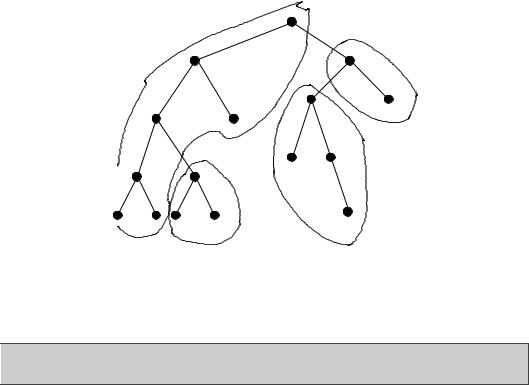
6.1. INFORMATION MODELS AND DIRECTORY SERVICES |
199 |
X.500 originally followed a naming scheme based in geographical regions, but has since moved towards a naming scheme based on the virtual geography of the Domain Name Service (DNS). To map a DNS name to a Distinguished Name, one uses the ‘dc’ attribute, e.g. for the domain name of Oslo University College (hio.no)
dc=hio,dc=no
Hierarchical directory services are well suited to being distributed or delegated to several hosts. A Directory Information Tree is partitioned into smaller regions, each of which is a connected subtree, which does not overlap with other subtree partitions (see figure 6.1). This allows a number of cooperating authorities within an organization to maintain the data more rationally, and allows – at least in principle – the formation of a global directory, analogous to DNS. Availability and redundancy can be increased by running replication services, giving a backup or fail-over functionality. A master server within each partition keeps master records and these are replicated on slave systems. Some commercial implementations (e.g. NDS) allow multi-master servers.
Figure 6.1: The partitioning of a distributed directory. Each dotted area is handled by a separate server.
The software that queries directories is usually built into application software.
Definition 4 (Directory User Agent (DUA)). A program or subsystem that queries a directory service on behalf of a user.
For example, the name resolver library in Unix supports the system call ‘gethostbyname’, which is a system call delegating a query to the hostname directory. The ‘name server switch’ is used in Unix to select a policy for querying a variety of competing directory services (see section 4.6.5), as are Pluggable Authentication Modules (PAM).

200 CHAPTER 6. MODELS OF NETWORK AND SYSTEM ADMINISTRATION
6.1.2Unix legacy directories
Before networking became commonplace, Unix hosts stored directory information in the /etc file directory, in files such as /etc/passwd, /etc/services and so on. In the 1980s this was extended by a network service that could bind hosts together with a common directory for all hosts in a Local Area Network. Sun Microsystems, who introduced the service, called it ‘YP’ or Yellow Pages, but later had to change the name to the Network Information Service (NIS) due to a trademarking conflict with British Telecom (BT). The original NIS directory was very popular, but was both primitive, non-hierarchical and lacked an effective security model and was thus replaced by ‘NIS+’ which was able to add strong authentication to queries, and allow modernized and more flexible schema. NIS+ never really caught on, and it is now being replaced by an open standard LDAP.
6.1.3OpenLDAP
The OpenLDAP implementation is the reference implementation for Unix-like systems. Directory information can be accessed through a variety of agents, and can be added to the Unix name server list via nsswitch.conf and Pluggable Authentication Modules (PAM). The strength of LDAP is its versatility and interoperability with all operating systems. Its disadvantage is its somewhat arbitrary and ugly syntactical structure, and its vulnerability to loss of network connectivity. See section 7.12.2 for more details.
6.1.4Novell Directory Service – NDS
Novell Netware is sometimes referred to as a Network Operating System (NOS) by PC administrators, because it was the ‘add on’ software that was needed to complete the aging MSDOS software for the network sharing age. Novell Netware was originally a centralized sharing service that allowed a regiment of PCs to connect to a common disk and a common printer, thus allowing expensive hardware to be shared amongst desktop PCs.
As PCs have become more network-able, Netware has developed into a sophisticated directory-based server suite. The Novell directory keeps information about all devices and users within its domain: users, groups, print queues, disk volumes and network services. In 1997, LDAP was integrated into the Novell software, making it LDAP compatible and allowing cross-integration with Unix based hosts. In an attempt to regain market share, lost to Microsoft and Samba (a free software alternative for sharing Unix filesystems with Windows hosts, amongst other things), Novell has launched its eDirectory at the core of Directory Enabled Net Infrastructure Model (DENIM), that purports to run on Netware, Windows, Solaris, Tru64 and Linux. Perhaps more than any other system, Novell Netware adopted a consistent distributed physical organization of its devices and software objects in its directory model. In Novell, a directory does not merely assist the organization: the organization is a directory that directly implements the information model of the organization.
6.2. SYSTEM INFRASTRUCTURE ORGANIZATION |
201 |
6.1.5Active Directory – AD
Early versions of Windows were limited by a flat host infrastructure model that made it difficult to organize and administer Windows hosts rationally by an information model. Active Directory is the directory service introduced with and integrated into Windows 2000. It replaces the Domain model used in NT4, and is based on concepts from X.500. It is LDAP compatible. In the original Windows network software, naming was based around proprietary software such as WINS. Windows has increasingly embraced open standards like DNS, and has chosen the DNS naming model for LDAP integration.
The smallest LDAP partition area in Active Directory is called a domain to provide a point of departure for NT4 users. The Active Directory is still being developed. Early versions did not support replication, and required dedicated multiple server hosts to support multiple domains. This has since been fixed.
The schema in Active Directory differ slightly from the X.500 information model. Auxiliary classes do not exist as independent classes, rather they are incorporated into structural classes. As a result, auxiliary classes cannot be searched for, and cannot be added dynamically or independently. Other differences include the fact that all RDNs must be single valued and that matching rules are not published for inspection by agents; searching rules are hidden.
6.2 System infrastructure organization
As we have already mentioned in section 3.1, a network is a community of cooperating and competing components. A system administrator has to choose the components and assign them their roles on the basis of the job which is intended for the computer system. There are two aspects of this to consider: the machine aspect and the human aspect. The machine aspect relates to the use of computing machinery to achieve a functional infrastructure; the human aspect is about the way people are deployed to build and maintain that infrastructure.
Identifying the purpose of a computer system is the first step to building a successful one. Choosing hardware and software is the next. If we are only interested in word-processing, we do not buy a supercomputer. On the other hand, if we are interested in high volume distributed database access, we do not buy a laptop running Windows. There is always a balance to be achieved, a right place to spend money and right place to save money. For instance, since the CPU of most computers is idle some ninety percent of the time, simply waiting for input, money spent on fast processors is often wasted; conversely, the greatest speed gains are usually to be made in extra RAM memory, so money spent on RAM is usually well spent. Of course, it is not always possible to choose the hardware we have to work with. Sometimes we inherit a less than ideal situation and have to make the best of it. This also requires ingenuity and careful planning.
6.2.1Team work and communication
The process of communication is essential in any information system. System administration is no different; we see essential bi-directional communications

202 CHAPTER 6. MODELS OF NETWORK AND SYSTEM ADMINISTRATION
taking place in a variety of forms:
•Between computer programs and their data,
•Between computers and devices,
•Between collaborating humans (in teams),
•Between clients and servers,
•Between computer users and computer systems,
•Between policy decision-makers and policy enforcers,
•Between computers and the environment (spilled coffee).
These communications are constantly being intruded upon by environmental noise. Errors in this communication process can occur in two ways:
•Information is distorted, inserted or omitted, by faulty communication, or by external interference,
•Information is interpreted incorrectly; symbols are incorrectly identified, due to imprecision or external interference (see figure 6.2).
For example, suppose one begins with the simplest case of a stand-alone computer, with no users, executing a program in isolation. The computer is not communicating with any external agents, but internally there is a fetch–execute cycle, causing data to be read from and written to memory, with a CPU performing manipulations along the way. The transmission of data, to and from the memory, is subject to errors, which are caused by electrical spikes, cosmic rays, thermal noise and all kinds of other effects.
Suppose now that an administrator sends a configuration message to a host, or even to a single computer program. Such a message takes place by some agreed form of coding: a protocol of some kind, e.g. a user interface, or a message format. Such a configuration message might be distorted by errors in communication, by software errors, by random typing errors. The system itself might change during the implementation of the instructions, due to the actions of unknown parties, working covertly. These are all issues which contribute uncertainty into the configuration process and, unless corrected, lead to a ‘sickness’ of the system, i.e. a deviation from its intended function.
Consider a straightforward example: the application of a patch to some programming code. Programs which patch bugs in computer code only work reliably if they are not confused by external (environmental) alterations performed outside the scope of their jurisdiction. If a line break is edited in the code, in advance, this can be enough to cause a patch to fail, because the semantic content of the file was distorted by the coding change (noise). One reason why computer systems have been vulnerable to this kind of environmental noise, traditionally, is that error correcting protocols of sufficient flexibility have not been available for making system changes. Protocols, such as SNMP or proprietary change mechanisms, do not yet incorporate feedback checking of the higher level protocols over extended periods of time.
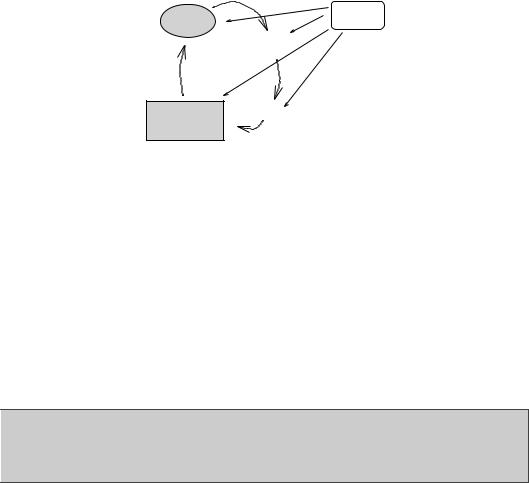
6.2. SYSTEM INFRASTRUCTURE ORGANIZATION |
203 |
Humans working in teams can lead to an efficient delegation of tasks, but also an inconsistent handling of tasks – i.e. a source of noise. At each level of computer operation, one finds messages being communicated between different parties. System administration is a meta-program, executed by a mixture of humans and machines, which concerns the evolution and maintenance of distributed computer systems. It involves:
•Configuring systems within policy guidelines,
•Keeping machines running within policy guidelines,
•Keeping user activity within policy guidelines.
Quality control procedures can help to prevent teams from going astray.
rule |
users |
|
|
|
message |
noise
computer
Figure 6.2: A development loop, showing the development of a computer system in time, according to a set of rules. Users can influence the computer both through altering the rules, altering the conditions under which the rules apply, and by directly touching the computer and altering its configuration.
6.2.2Homogeneity
Assuming that we can choose hardware, we should weigh the convenience of keeping to a single type of hardware and operating system (e.g. just PCs with NT) against the possible advantages of choosing the absolutely best hardware for the job. Product manufacturers (vendors) always want to sell a solution based on their own products, so they cannot be trusted to evaluate an organization’s needs objectively. For many issues, keeping to one type of computer is more important than what the type of computer is.
Principle 30 (Homogeneity/Uniformity I). System homogeneity or uniformity means that all hosts appear to be essentially the same. This makes hosts predictable for users and manageable for administrators. It allows for reuse of hardware in an emergency.
If we have a dozen machines of the same type, we can establish a standard routine for running them and for using them. If one fails, we can replace it with another.

204 CHAPTER 6. MODELS OF NETWORK AND SYSTEM ADMINISTRATION
A disadvantage with uniformity is that there are sometimes large performance gains to be made by choosing special machinery for a particular application. For instance, a high availability server requires multiple, fast processors, lots of memory and high bandwidth interfaces for disk and network. In short it has to be a top quality machine; a word-processor does not. Purchasing such a machine might complicate host management slightly. Tools exist to help integrate hosts with special functions painlessly.
Having chosen the necessary hardware and software, we have to address the function of each host within the community, i.e. the delegation of specialized tasks called services to particular hosts, and also the competition between users and hosts for resources, both local and distributed. In order for all of this to work with some measure of equilibrium, it has to be carefully planned and orchestrated.
6.2.3Load balancing
In the deployment of machinery, there are two opposing philosophies: one machine, one job, and the consolidated approach. In the first case, we buy a new host for each new task on the network. For instance, there is a mail server and a printer server and a disk server, and so on. This approach was originally used in PC networks running DOS, because each host was only capable of running one program at a time. That does not mean that it is redundant today: the distributed approach still has the advantage of spreading the load of service across several hosts. This is useful if the hosts are also workstations which are used interactively by users, as they might be in small groups with few resources. Making the transition from a mainframe to a distributed solution was discussed in a case study in ref. [308].
On the whole, modern computer systems have more than enough resources to run several services simultaneously, so the judgment about consolidation or distribution has to be made on a case-by-case basis, using an analytical evaluation. Indeed, a lot of unnecessary network traffic can be avoided by placing all file services (disk, web and FTP) on the same host, see chapter 9. It does not necessarily make sense to keep data on one host and serve them from another, since the data first have to be sent from the disk to the server and then from the server to the client, resulting in twice the amount of network traffic.
The consolidated approach to services is to place them all on just a few serverhosts. This can plausibly lead to better security in some cases, though perhaps greater vulnerability to failure, since it means that we can exclude users from the server itself and let the machine perform its task.
Today most PC network architectures make this simple by placing all of the burden of services on specialized machines which they call ‘servers’ (i.e. serverhosts). PC server-hosts are not meant to be used by users themselves: they stand apart from workstations. With Unix-based networks, we have complete freedom to run services wherever we like. There is no principal difference between a workstation and a server-host. This allows for a rational distribution of load.
Of course, it is not just machine duties which need to be balanced throughout the network, there is also the issue of human tasks, such as user registration,

6.2. SYSTEM INFRASTRUCTURE ORGANIZATION |
205 |
operating system upgrades, hardware repairs and so on. This is all made simpler if there is a team of humans, based on the principle of delegation.
Principle 31 (Delegation II). For large numbers of hosts, distributed over several locations, a policy of delegating responsibility to local administrators with closer knowledge of the hosts’ patterns of usage minimizes the distance between administrative center and zone of responsibility. Zones of responsibility allow local experts to do their jobs.
This suggestion is borne out by the model scalability arguments in section 6.3.
It is important to understand the function of a host in a network. For small groups in large organizations, there is nothing more annoying than to have central administrators mess around with a host which they do not understand. They will make inappropriate changes and decisions.
Zones of responsibility have as much to do with human limitations as with network structure. Human psychologists have shown that each of us has the ability to relate to no more than around 150 people. There is no reason to suppose that this limitation does not also apply to other objects which we assemble into our work environment. If we have 4000 hosts which are identical, then that need not be a psychological burden to a single administrator, but if those 4000 consist of 200 different groups of hosts, where each group has its own special properties, then this would be an unmanageable burden for a single person to cope with. Even with special software, a system administrator needs to understand how a local milieu uses its computers, in order to avoid making decisions which work against that milieu.
6.2.4Mobile and ad hoc networks
Not all situations can be planned for in advance. If we suppose that system design can be fully determined in advance of its deployment, then we are assuming that systems remain in the same configuration for all time. This is clearly not the case. One must therefore allow for the possibility of random events that change the conditions under which a system operates. One example of this is the introduction of mobile devices and humans. Mobility and partial connectivity of hosts and users is an increasingly important issue in system administration and it needs to be built into models of administration.
An ‘ad hoc’ network (AHN) is defined to be a networked collection of mobile objects, each of which has the possibility to transmit information. The union of those hosts forms an arbitrary graph that changes with time. The nodes, which include humans and devices, are free to move randomly thus the network topology may change rapidly and unpredictably. Clearly, ad hoc networks are important in a mobile computing environment, where hosts are partially or intermittently connected to other hosts, but they are also important in describing the high level associations between parts of a system. Who is in contact with whom? Which ways do information flow?
While there has been some discussion of decentralized network management using mobile agents [333], the problem of mobile nodes (and so strongly timevarying topology) has received little attention. However, we will argue below that ad

206 CHAPTER 6. MODELS OF NETWORK AND SYSTEM ADMINISTRATION
hoc networks provide a useful framework for discussing the problems surrounding configuration management in all network types, both fixed and mobile. This should not be confused with the notion of ‘ad hoc management’ [204], which concerns randomly motivated and scheduled checks of the hosts.
6.2.5Peer-to-peer services
Another phenomenon that has received attention in recent years is the idea of peered networks, i.e. not hierarchical structures in which there are levels of authority, but networks in which each user has equal authority.
The emergence of network file sharing applications, such as Napster and Gnutella, has focused attention on an architecture known as peer-to-peer, whose aim is to provide world-wide access to information via a highly decentralized network of ’peers’. An important challenge to providing a fully distributed information sharing system is the design of scalable algorithmic solutions. Algorithms such as those for routing and searching peer-to-peer networks are typically implemented in the form of an application-level protocol.
Definition 5 (Peer-to-peer application). A peer-to-peer network application is one in which each node, at its own option, participates in or abstains from exchanging data with other nodes, over a communications channel.
Peer-to-peer has a deeper significance than communication. It is about the demotion of a central authority, in response to the political wishes of those participating in the network. This is clearly an issue directly analogous to the policies used for configuration management. In large organizations, i.e. large networks, we see a frequent dichotomy of interest:
• At the high level, one has specialized individuals who can paint policy in broad strokes, dealing with global issues such as software versions, common security issues, organizational resource management, and so on. Such issues can be made by software producers, system managers and network managers.
•At the local level, users are more specialized and have particular needs, which large-scale managers cannot address. Centralized control is therefore only a partial strategy for success. It must be supplemented by local know-how, in response to local environmental issues. Managers at the level of centralized control have no knowledge of the needs of specialized groups, such as the physics department of a university, or the research department of a company. In terms of configuration policy, what is needed is the ability to accept the advice of higher authorities, but to disregard it where it fails to meet the needs of the local environment. This kind of authority delegation is not well catered for by SNMP-like models. Policy-based management attempts to rectify some of these issues [86].
What we find then is that there is another kind of networking going on: a social network, superimposed onto the technological one. The needs of small clusters of users override the broader strokes painted by wide-area management.
This is the need for a scaled approach to system management [47].
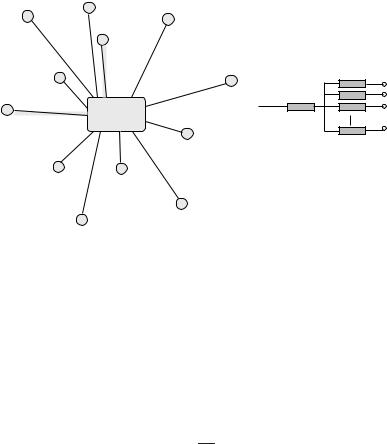
6.3. NETWORK ADMINISTRATION MODELS |
207 |
6.3 Network administration models
The management of clusters of systems leads to the concept of logistic networks. Here it is not the physical connectivity that is central to the deployment, but rather the associative relationships and channels of communication. Here, we follow the discussion in ref. [53].
Central management ‘star’ model
The traditional (idealized) model of host configuration is based on the idea of remote management (e.g. using SNMP). Here one has a central manager who decides and implements policy from a single location, and all networks and hosts are considered to be completely reliable. The manager must monitor the whole network, using bi-directional communication. This leads to an N : 1 ratio of clients to manager (see figure 6.3). This first model is an idealized case in which there is no unreliability in any component of the system. It serves as a point of reference.
Controller
Figure 6.3: Model 1: the star network. A central manager maintains bi-directional communication with all clients. The links are perfectly reliable, and all enforcement responsibility lies with the central controller.
The topology on the left-hand side of figure 6.3 is equivalent to that on the right-hand side. The request service capacity of the controller is thus:
Icontroller = I1 + I2 + · · · + IN . |
(6.1) |
The controller current cannot exceed its capacity, which we denote by CS . We assume that the controller puts out the flow of repair instructions at its full capacity; this gives the simple maximum estimate
Irepair = |
CS |
(6.2) |
N . |
The total current is limited only by the bottleneck of queued messages at the controller, thus the throughput per node is only 1/N of the total capacity. This
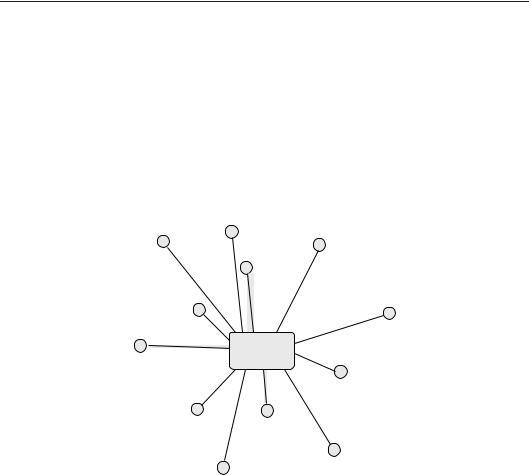
208 CHAPTER 6. MODELS OF NETWORK AND SYSTEM ADMINISTRATION
highlights the clear disadvantage of centralized control, namely the bottleneck in communication with the controller.
Models 1 and 2: Star model in intermittently connected environment
The previous model was an idealization, and was mainly of interest for its simplicity. Realistic centralized management must take into account the unreliability of the environment (see figure 6.4).
In an environment with partially reliable links, a remote communication model bears the risk of not reaching every host. If hosts hear policy, they must accept and comply; if not, they fall behind in the schedule of configuration. Monitoring in distributed systems has been discussed in ref. [3].
Controller
Figure 6.4: Model 2: a star model with built-in unreliability. Enforcement is central as in Model 1.
The capacity of the central manager CS is now shared between the average number of hosts N that is available. The result is much the same as for Model 1, the completely reliable star. This is because there is an implicit assumption that the controller was clever enough to find (with negligible overhead) those hosts that are available at any given time, and so to only attempt to communicate with them – no latencies or other probabilities of unavailability were included.
This model then fails (perhaps surprisingly), on average, at the same threshold value for N as does Model 1. If the hunt for available nodes places a non-negligible burden on the controller capacity, then it fails at a lower threshold.
Model 3: Mesh topology with centralized policy and local enforcement
The serialization of tasks in the previous models forces configuration ‘requests’ to queue up on the central controller. Rather than enforcing policy by issuing every instruction from the central source, it makes sense to download a summary of the policy to each host and empower the host itself to enforce it.

6.3. NETWORK ADMINISTRATION MODELS |
209 |
There is still a centrally determined policy for every host, but now each host carries the responsibility of configuring itself. There are thus two issues: i) the update of the policy and ii) the enforcement of the policy. A pull model for updating policy is advantageous here, because every host then has the option to obtain updates at a time convenient to itself, avoiding confluence contentions (clients might not even be switched on or connected to a mobile network when the controller decides to send its information); moreover, if it fails to obtain the update, it can retry until it succeeds. We ask policy to contain a self-referential rule for updating itself.
The distinction made here between communication and enforcement is important because it implies distinct types of failure, and two distinct failure metrics: i) distance of the locally understood policy from the latest version, and ii) distance of the host configuration from the ideal policy configuration. In other words: i) communication failure, and ii) enforcement failure.
In this model, the host no longer has to share any bandwidth with its peers, unless it is updating its copy of the policy, and perhaps not even then, since policy is enforced locally and updates can be scheduled to avoid contention. The load on the controller is also much smaller in this model, because the model does not rely on the controller for every operation, only for a copy of its cache-able policy. The nodes can cooperate in diffusing policy updates via flooding.1 (See figure 6.5.)
The worst case – in which the hosts compete for bandwidth, and do not use flooding – is still an improvement over the two previous models, since the rate at which updates of policy are required is much less than the traffic generated by the constant to and fro of the much more specific messages in the star models. However, note that this can be further improved upon by allowing flooding of updates: the authorized policy instruction can be available from any number of redundant sources, even though the copies originate from a central location. In this case, the model truly scales without limit.
There is one caveat to this encouraging result. If the (meshed) network of hosts is truly an ad hoc network of mobile nodes, employing wireless links, then connections are not feasible beyond a given physical range r. In other words, there are no long-range links: no links whose range can grow with the size of the network. As a result of this, if the AHN grows large (at fixed node density), the
path length (in hops) between any node and the controller scales as a constant
√
times N. This growth in path length limits the effective throughput capacity
between node and controller, in a way analogous to the internode capacity. The
√
latter scales as 1/ N [137, 193]. Hence, for sufficiently large N , the controller and AHN will fail collectively to convey updates to the net. This failure will occur at a threshold value defined by
CS |
= 0, |
(6.3) |
Ifail(ii) = Iupdate − c√Nthresh |
where c is a constant. The maximal network size Nthresh is in this case proportional
2
to I CS , still considerably larger than for Models 1 and 2.
update
1Note, flooding in the low-level sense of a datagram multicast is not necessarily required, but the effective dissemination of the policy around the network is an application-layer flood.
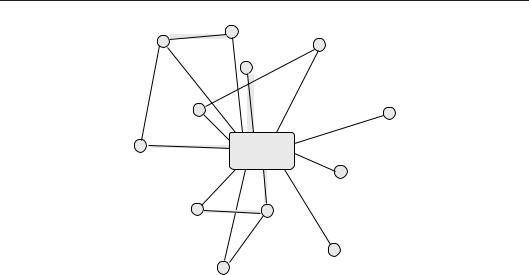
210 CHAPTER 6. MODELS OF NETWORK AND SYSTEM ADMINISTRATION
Controller
Figure 6.5: Model 3 mesh topology. Nodes can learn the centrally-mandated policy from other nodes as well as from the controller. Since the mesh topology does not assure direct connection to the controller, each node is responsible for its own policy enforcement.
Model 4: Mesh topology, partial host autonomy and local enforcement
As a variation on the previous model, we can begin to take seriously the idea of allowing hosts to decide their own policy, instead of being dictated to. In this model, hosts can choose not to receive policy from a central authority, if it conflicts with local interests. Hosts can make their own policy, which could be in conflict or in concert with neighbors. (See figure 6.6.)
Communication thus takes the role of conveying ‘suggestions’ from the central authority, in the form of the latest version of the policy. For instance, the central authority might suggest a new version of widely-used software, but the local authority might delay the upgrade due to compatibility problems with local hardware. Local enforcement is now employed by each node to hold to its chosen policy Pi . Thus communication and enforcement use distinct channels (as with Model 3); the difference is that each node has its own target policy Pi which it must enforce.
Thus the communications and enforcement challenges faced by Model 4 are the same (in terms of scaling properties) as for Model 3. Hence this model can in principle work to arbitrarily large N .
Model 4 is the model used by cfengine [41, 49]. The largest current clusters sharing a common policy are known to be of the order 104 hosts, but this could soon be of the order 106, with the proliferation of mobile and embedded devices.
Model 5: Mesh, with partial autonomy and hierarchical coalition
An embellishment of Model 4 is to allow local groups of hosts to form policy coalitions that serve to their advantage. Such groups of hosts might belong to one
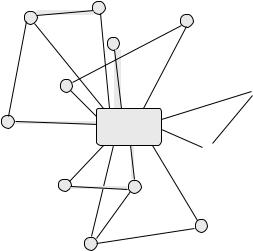
6.3. NETWORK ADMINISTRATION MODELS |
211 |
?
?
?
?
?
 ?
?
?
Controller
 ?
?
?
?
?
?
Figure 6.6: Model 4. As in Model 3, except the hosts can choose to disregard or replace aspects of policy at their option. Question marks indicate a freedom of hosts to choose.
department of an organization, or to a project team, or even to a group of friends in a mobile network (see figure 6.7).
Once groups form, it is natural to allow sub-groups and thence a generalized hierarchy of policy refinement through specialized social groups.
If policies are public then the scaling argument of Model 3 still applies since any host could cache any policy; but now a complete policy must be assembled from several sources. One can thus imagine using this model to distribute policy so as to avoid contention in bottlenecks, since load is automatically spread over multiple servers. In effect, by delegating local policy (and keeping a minimal central policy) the central source is protected from maximal loading. Specifically, if there are S sub-controllers (and a single-layer hierarchy), then the effective update capacity
is multiplied by S. Hence the threshold Nthresh is multiplied (with respect to that for Model 3) by the same factor.
This model could be implemented using cfengine, with some creative scripting.
Model 6: Mesh, with partial autonomy and inter-peer policy exchange
The final step in increasing autonomy is the free exchange of information between arbitrary hosts. Hosts can now offer one another information, policy or source materials in accordance with an appropriate trust model. In doing so, impromptu coalitions and collaborations wax and wane, driven by both human interests and possibly machine learning. A peer-to-peer policy mechanism of this type invites trepidation amongst those versed in control mechanisms, but it is really no more than a distributed genetic algorithm. With appropriate constraints it could be made to lead to sensible convergent behavior, or to catastrophically unstable behavior (see figure 6.8).
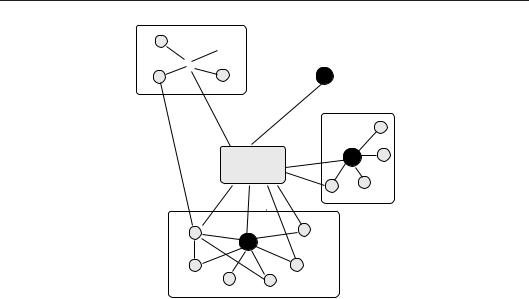
212 CHAPTER 6. MODELS OF NETWORK AND SYSTEM ADMINISTRATION
? 
 ?
?
?
Controller
?
Figure 6.7: Model 5. Communication over a mesh topology, with policy choice made hierarchically. Sub-controllers (dark nodes) edit policy as received from the central controller, and pass the result to members of the local group (as indicated by dashed boxes). Question marks indicate the freedom of the controllers to edit policy from above.
One example of such a collaborative network that has led to positive results is the Open Source Community. The lesson of Open Source Software is that it leads to a rapid evolution. A similar rapid evolution of policy could also be the result from such exchanges. Probably policies would need to be weighted according to an appropriate fitness landscape. They could include things like shared security fixes, best practices, code revisions, new software, and so on.
Until this exchange nears a suitable stationary point, policy updates could be much more rapid than for the previous models. This could potentially dominate configuration management behavior.
Note that this model has no center. Hence it is, by design, scale-free: all significant interactions are local. Therefore, in principle, if the model can be made to work at small system size, then it will also work at any larger size.
In practice, this model is subject to potentially large transients, even when it is on its way to stable, convergent behavior. These transients would likely grow with the size of the network. Here we have confined ourselves to long-time behavior for large N – hence we assume that the system can get beyond such transients, and so find the stable regime.
Finally, we note that we have only assessed the goodness of a given model according to its success in communicating and enforcing policy. When policy is centrally determined, this is an adequate measure of goodness. However, for those cases in which nodes can choose policy, one would also like to evaluate the goodness of the resulting choices. We do not address this important issue here. We note however that Model 6, of all the models presented here, has the greatest freedom to explore the space of possible policies. Hence an
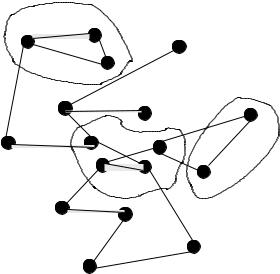
6.4. NETWORK MANAGEMENT TECHNOLOGIES |
213 |
Figure 6.8: Model 6. Free exchange of policies in a peer-to-peer fashion; all nodes have choice (dark). Nodes can form spontaneous, transient coalitions, as indicated by the dashed cells. All nodes can choose; question marks are suppressed.
outstanding and extremely nontrivial question for this peer-to-peer model of configuration management is: can such a system find ‘better’ policies than centralized systems?
In short, this model has no immediate scaling problems with respect to communication and enforcement. Open questions include the scaling behavior of transients, and the ability of this completely decentralized model to find good policy.
6.4 Network management technologies
The ability to read information about the performance of network hardware via the network itself is an attractive idea. Suppose we could look at a router on the second floor of a building half a mile away and immediately see the load statistics, or the number of rejected packets it has seen; or perhaps the status of all printers on a subnet. That would be useful diagnostic information. Similar information could be obtained about software systems on any host.
6.4.1SNMP network management
The Simple Network Management Protocol (SNMP) is a protocol designed to do just this [59, 268, 269]. SNMP was spawned in 1987 as a Simple Gateway Monitoring Protocol, but was quickly extended and became a standard for network monitoring. SNMP was designed to be small and simple enough to be able to run on even minor pieces of network technology like bridges and printers. The model
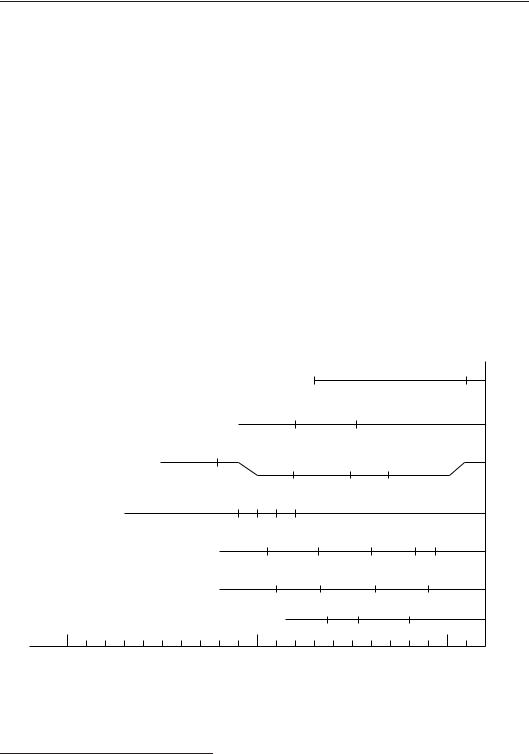
214 CHAPTER 6. MODELS OF NETWORK AND SYSTEM ADMINISTRATION
of configuration management is particularly suited to non-interactive devices like printers and static network infrastructure that require an essentially static configuration over long periods of time. SNMP has since been extended, with less success, to some aspects of host management such as workstations and PC network server configuration; however, the static model of configuration is less appropriate here since users are constantly perturbing servers in unpredictable ways and, combined with the unimpressive security record of early versions, this has discouraged its use for host management.
SNMP now exists in three versions (see figure 6.9). The traditional SNMP architecture is based on two entities: managers and agents. SNMP managers execute management applications, while SNMP agents mediate access to management variables. These variables hold simple typed values and are arranged into groups of scalars of single-valued variables or into conceptual tables of multi-valued variables. The set of all variables on a managed system is called the Management Information Base (MIB).2
SNMP has often been criticized for the weak security of its agents, which are configured by default with a clear text password of ‘public’. Version 3 of the SNMP protocol was finally agreed on and published in December 2002 in order to address these problems, using strong encryption methods. If or when this version becomes widespread, SNMP will be as secure as any other network service.
|
|
|
|
|
|
1.0.0 |
|
|
|
|
|
2.0.0 |
|
|
|
|
|
CFENGINE (OUC) |
|
|
|
|
|
|
|
||
|
|
|
|
|
|
1.0 |
|
|
2.0 |
|
|
|
2.6 |
|
|
|
CORBA (OMG) |
|
|
|
|
|
|
|
|
|
|
|
TMN (ITU) |
|
M.30 |
|
|
|
|
|
|
|
|
|
|
|
|
|
|
M.3010 |
M.3100 |
M.3400 |
|
|
|||||
|
|
|
|
RM.4 CMIP CMIS GDMO |
|
|
|
|
|
|
|||
CMIP (ISO) |
|
|
|
|
|
|
|
|
|
|
|
|
|
|
|
|
SNMP (IETF) |
SMPv1 |
SNMPv2p |
SNMPv2c SNMPv3 |
SNMP3 |
||||||
|
|
|
|
|
|
|
|
|
|
|
|
||
|
|
|
|
|
SMIv1 |
SMIv2 |
|
SMIv2 |
SMIv2 |
|
|||
|
|
|
SMI (IETF) |
|
|
|
|
|
|
|
|
|
|
|
|
|
|
|
|
|
LDAP |
|
LDAPv2 |
LDAPv3 |
|
|
|
|
|
|
|
LDAP (IETF) |
|
|
|
|
|
|
|
|
|
1980 |
1982 |
1984 |
1986 |
1988 |
1990 |
1992 |
1994 |
1996 |
|
1998 |
2000 |
2002 |
|
Figure 6.9: A historical perspective of some network management technologies.
SNMP supports three operations on devices: read, write and notify (through ‘traps’). The management console can read and modify the variables stored on a device (see section 7.10) and issue notifications of special events. SNMP access is
2The term MIBs is sometimes used to refer to the collection of variables on a box and, in other contexts, to the SMI module defining the semantics, data types and names of variables.
6.4. NETWORK MANAGEMENT TECHNOLOGIES |
215 |
mediated by a server process on each hardware node (the agent), which normally communicates by UDP/IP on ports 161 and 162. Modern operating systems often run SNMP daemons or services which advertise their status to an SNMP-capable manager. The services are protected by a rather weak password which is called the community string.
Because SNMP is basically a ‘peek–poke’ protocol for simple values, its success depends crucially on the ability of the Management Information Bases or MIBs to correctly characterize the state of devices, and how the agents translate MIB values into real actions. For monitoring workload (e.g. load statistics on network interfaces, or out-of-paper signals on a printer), this model is clearly quite good. Indeed, even host-based tools (ps, top, netstat etc.) use this approach for querying resource tables on more complex systems. Moreover, in the case of dumb network devices, whose behavior is essentially fixed by a few parameters or lists of them (printers, switches etc.), this model even meets the challenge of configuration reasonably well.
The notify functionality is implemented by ‘traps’ or events that can be configured in the SNMP agent. Each event type is defined by the SNMP software of the device being managed, e.g. Cisco routers have general traps, such as:
coldStart linkDown linkUp
authenticationFailure egpNeighborLoss reload tcpConnectionClose ciscoConfigManEvent
that are triggered by interface changes and management events.
The variables that exist in an MIB are formally defined in so-called MIB modules (RFC 1213) that are written in a language called the Structure of Management Information (SMI). The SMI provides a generic and extensible name-space for identifying MIB variables. Due to a lack of higher level data structuring facilities, MIB modules often appear as a patchwork of individual variable definitions rather than a class structure in Java or other object-oriented languages. An SNMP request specifies the information it wants to read/write by giving the name of an instance of the variable to read or write in a request. This name is assigned in the formal MIB module. There are standard MIB modules for address translation tables, TCP/IP statistics and so on. These have default parameters that can be altered by SNMP: system name, location and human contact; interface state (up/down), hardware and IP address, IP state (forwarding gateway/not) IP TTL, IP next HOP address, IP route age and mask, TCP state, neighbor state, SNMP trap enabling, and so on.
Although SNMP works fairly well for monitoring clusters of static devices, its success in managing hosts, including workstations and servers, is more questionable. Even disregarding the scalability problems noted in section 6.3, the MIB model is very difficult to tailor to hosts where users are interacting with the system constantly. Hosts are no longer basically predictable devices with approximately

216 CHAPTER 6. MODELS OF NETWORK AND SYSTEM ADMINISTRATION
constant state; their state changes dynamically in response to user interaction, and in response to the services they perform. The SNMP management philosophy, i.e. of communicating with an agent for reading and writing, is only effective when the rate of change of state of a device is slow, i.e. when the device changes only at about the same rate as the rate of change of policy itself. Moreover, the complexity of operations that can be carried out by a dumb SNMP agent, based only on MIB ‘push button’ instructions and a bilateral communication with a management interface, is limited. Thus, in practice, SNMP can only be used to detect problems, not to repair them. This is not so much a problem in the model, but in the manner in which it is implemented. If SNMP agents contained on-board intelligence, then the communication model could be retained. One is then into the territory of more intelligent agent systems like cfengine and PIKT.
Despite the shortcomings of SNMP for host operations, many operating systems do define their own MIBs for the collection of system performance data and even for essential configuration parameters. Some commercial network management systems like Hewlett Packard’s OpenView work by reading and writing MIBs using SNMP client-server technology. Most Unix variants, Novell and NT now also support SNMP. Their MIBs can be used even to collect information such as the names of users who are logged on. This information is not particularly relevant to the problem of resource management and can even be considered a security risk, thus many remain sceptical about the use of SNMP on hosts.
In 1997, SNMPv3 was put forward in order to provide stronger security, particularly in the authentication of the manager–agent connection. This has helped to allay some of the fears in using SNMP where it is appropriate, but it does not make the task of tailoring the MIB model easier.
SNMP seems to be increasing in popularity for monitoring network hardware (routers and switches etc.), but like any public information database, it can also be abused by network attackers. SNMP is a prime target for abuse and some sites choose to disable SNMP services altogether on hosts, using it only for monitoring network transport hardware.
Suggestion 7 (SNMP containment). Sites should filter SNMP packets to and from external networks to avoid illegal access of these services by intruders.
6.4.2OSI, TMN and others
SNMP has many competitors. The International Telecommunications Union (ITU) has defined the Telecommunications Management Network (TMN) standards for managing telecommunications networks [205]. It is an alternative scheme designed for telecommunications networks and has a strong relationship with the OSI Management Model known as the Common Management Information Protocol (CMIP). Common Object Request Broker Architecture (CORBA) is now being adopted as the middle-ware for TMN. The Distributed Management Task Force (DMTF) developed the Desktop Management Interface (DMI) until 1998. Moreover, central to several configuration management schemes is LDAP, the lightweight directory service (see section 9.8). Recently, a rival IETF group began work on a competing system to SNMP called COPS-PR [101].

6.4. NETWORK MANAGEMENT TECHNOLOGIES |
217 |
These systems all use an abstraction based on the concept of ‘managed objects’. A different approach is used by systems like cfengine [41] and PIKT [231], which use descriptive languages to describe the attributes of many objects at the same time, and agents to enforce the rules.
The ISO 7498 Open System Interconnect (OSI) Model consists of a large number of documents describing different aspects of network communication and management.3 Amongst these is the basic conceptual model for management of networked computers. It consists of these issues:
•Configuration management
•Fault management
•Performance management
•Security management
•Accounting management.
Configuration management is taken to include issues such as change control, hardware inventory mapping, software inventories and customization of systems. Fault management includes events, alarms, problem identification, troubleshooting, diagnosis and fault logging. Performance covers capacity planning, availability, response times, accuracy and throughput. Security discusses policy, authorization, exceptions, logging etc. Finally, accounting includes asset management, cost controls and payment for services.
The OSI Management Model is rather general and difficult to disagree with, but it does not specify many details either. Its interpretation has often been somewhat literal in systems like TMN and SNMP.
6.4.3Java Management Extension (JMX)
Java Management Extension (JMX) is Java’s answer to dealing with managed objects. The paradigm of monitoring and changing object contents is absorbed into Java’s model of enterprise management. Its aim is to allow the management of new and legacy systems alike. The basic idea of JMX is not very different to that of SNMP, but the transport mechanisms are integrated into Java’s extensive middleware framework.
MX defines a standard instrumentation model, called MBeans, for use in Java programs and by Java management applications. JMX also specifies a set of complementary services that work with MBean instrumentation to monitor and manage Java-based applications. These services range from simple monitors and timers to a powerful relation service that can be used to create user-defined associations between MBeans in named roles and a mechanism for dynamically loading new instrumentation and services at run time.
3These documents must be purchased from the ISO web site.

218 CHAPTER 6. MODELS OF NETWORK AND SYSTEM ADMINISTRATION
6.4.4Jini and UPnP: management-free networks
Jini is a Java derivative technology that is aimed at self-configuring ad hoc networks. It is middle-ware that provides application programming interfaces (API) and networking protocols for discovery and configuration of devices that have only partial or intermittent connectivity. A similar project is Microsoft’s Universal Plug’n’Play (UPnP), a peer-to-peer initiative that uses existing standards like TCP/IP, HTTP and XML to perform a similar function. The aim of these technologies is to eliminate the need for system administrators, by making devices configure themselves.
In a traditional fixed infrastructure network, many services rely on the existence of the fixed infrastructure. If a host is removed or a new host is added to the network, a manual reconfiguration is often necessary. Jini and UPnP aim to remove the need for this manual reconfiguration by providing negotiation protocols that make computing devices much more ‘plug’n’play’. They are designed to accept all kinds of devices, including mobile computing platforms and home appliances. These technologies are hailed as the way forward towards pervasive computing, i.e. a future in which embedded networked computers are in appliances, walls, even clothes.
A Jini environment is a distributed environment. It requires a certain level of infrastructure in order to work, but it also provides redundancy and fail-over capabilities. Each device coupled to a network advertises its interfaces and services to the network, including information about who is allowed to communicate with it. Devices are represented as Java objects. Each device provides a set of services resulting in a federation. Two services of special interest are lookup and discovery services, which are responsible for allowing new devices to join an existing ad hoc federation.
No central authority controls this federation of devices. Jini is peer-to-peer in the sense that each device can act as a client or a server depending on whether it is providing or requesting a service. Services could be anything from file-transfer to querying temperature sensors in a building. In order to handle failures of infrastructure, Jini only leases a resource to a client for a fixed amount of time. After the term has expired, the client must renew the lease to continue using the service. The lease expires for all users if a service goes down. A device may then attempt to contact a different service provider if one is available, by looking for one in the published list of services.
The Java Naming and Directory Interface (JNDI) is the front-end to object naming and directory services on the network. It works in concert with other J2EE (Java 2 Enterprise Edition) components to organize and locate services. JNDI provides Java-enabled applications with a unified interface in an enterprise environment (see section 9.12).
In other distributed computing models, such as CORBA, DCOM, or even Unix RPC services, the functioning of services relies on client-server ‘stubs’ or protocol interfaces that handle the communication standards. These need to be in place before a device can communicate with other devices. Jini makes use of Web services and Java code portability to allow such a stub to be downloaded through a generic download mechanism. The only requirement is that all devices need
